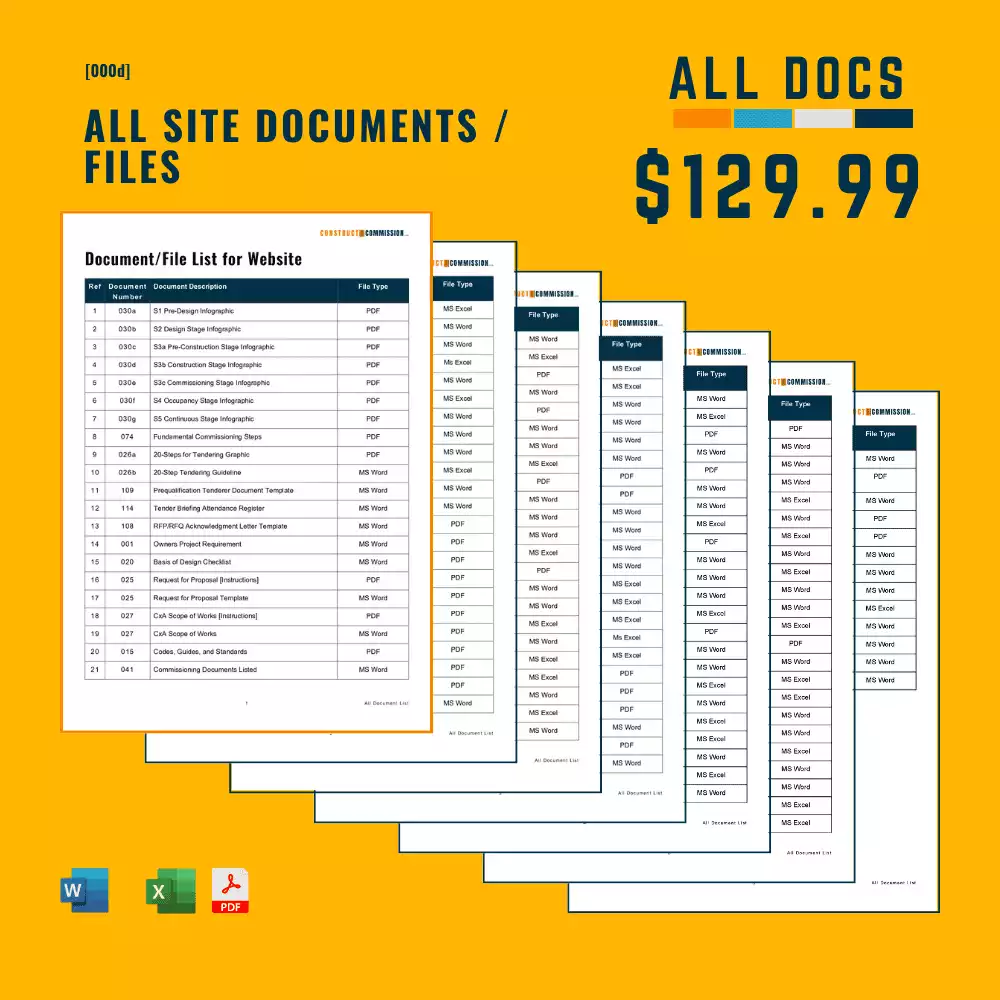In today’s interconnected and data-driven world, data centers are the backbone of the modern digital landscape, where they house the systems and equipment that power the digital services we rely on daily – from cloud computing and e-commerce to social media and critical business operations. As Data Center Commissioning Managers, we get to witness firsthand the pivotal role of data centers in shaping our technological landscape.
A data center is far more than just a physical facility filled with racks of servers and cables. It represents the culmination of advanced engineering, architecture, and cutting-edge technology, meticulously designed to handle the relentless demands of a hyper-connected world. These facilities are the heart of our digital infrastructure, acting as the nerve centers that store, process, and distribute the vast amounts of data that fuel our digital interactions.
Just ‘constructing’ a data center and letting it operate is insufficient to guarantee its seamless and efficient operation, and this is where the data center commissioning process enters.
Data center commissioning systematically and thoroughly validates the systems, equipment, and components, ensuring that all elements – from power distribution and cooling systems to security protocols, networking infrastructure, and controls – work harmoniously to provide optimal performance, reliability, and resilience.
Our job as Data Center Commissioning Managers involves carefully coordinating the setting up, testing, validating, and documenting of the equipment and systems, where minor details matter. We usually deploy a Commissioning Process to explain, detail, and document the steps needed to ensure the facility achieves its intended specified objectives.
This article will focus on data center commissioning, providing an overview of what it is and how to deploy it, with links and resources for further reading around this site.

🟩 Understanding Data Center Commissioning
🟧 What is Data Center Commissioning
Data center commissioning is a comprehensive and systematic process that involves verifying, validating, and testing all critical systems, equipment, and components within a data center facility. It ensures that the data center operates according to its design specifications, meets industry standards, and fulfills the functional requirements for optimal performance and reliability.
We should understand that Commissioning is not a one-time event but rather an ongoing endeavor that spans the entire data center lifecycle, from its initial design and construction to its day-to-day operation and eventual upgrades.
🟧 The Significance of Commissioning and Lifecycle.
The role of commissioning within a data center construction programme and its overall lifecycle cannot be overstated. It forms a crucial bridge between the planning and operational phases, supporting the translation of designs into functional reality. It acts as a quality assurance mechanism, ensuring the power, cooling, networking, security, and other essential systems operate harmoniously.
By thoroughly testing, documenting, and validating these systems, commissioning mitigates risks, identifies potential issues, and rectifies discrepancies before they escalate into costly disruptions or failures later in their operation, which can have significant consequences in an era where downtime can translate to substantial financial losses and reputational damage,
Commissioning is a safeguard, enhancing the data center’s reliability and resilience.
🟧 5 Key Objectives and Goals of Data Center Commissioning
The primary objectives of data center commissioning revolve around ensuring the data center’s operational readiness, optimizing its performance, and achieving high reliability.
The goals encompass several vital aspects:
- System Functionality: Commissioning verifies that all systems and components operate as intended, meeting the specified performance criteria and owners’ project requirements. This is achieved by meticulously testing power distribution systems, cooling systems, fire suppression systems, redundant/backup systems, and networking infrastructure.
- Efficiency and Performance: By fine-tuning and optimizing the data center’s systems, commissioning helps achieve optimal energy efficiency, reducing operational costs and minimizing environmental impact. It also ensures that the data center can handle varying workloads without compromising performance.
- Risk Mitigation: Commissioning identifies and addresses potential vulnerabilities within the data center’s electrical and cooling infrastructure, such as single points of failure. This proactive approach minimizes the risk of unplanned outages and data loss, thereby enhancing business continuity.
- Compliance and Standards: The overall process of commissioning will ensure that industry standards, regulations, codes, and best practices are being followed. This results in the facility having documented proof of adherence to established guidelines, which provides peace of mind to stakeholders and regulatory authorities.
- Documentation and Knowledge Transfer: Throughout the whole process, commissioning will generate comprehensive documentation detailing the data center’s design, specifications, test procedures, and results. This aids in knowledge transfer to the operational teams allowing effective and efficient management and maintenance.
🚀 The importance of data center commissioning becomes apparent when considering their significant impact on global energy consumption. According to industry studies and energy organizations, the worlds data centers consume approximately 1-2% of global electrical energy usage; and according to projections, data center energy consumption is expected to increase significantly in the coming years, potentially reaching up to 8% of the global electrical energy supply.
- Use Straight Away
- Insert in Tender Documents
- Industry Wide Process from Level 0 to Level 6
- Detailed Responsibility and Roles
- Includes Commissioning Checklist
Aimed at anyone who needs a detailed delivery plan and checklist for deploying Commissioning within a Data Center Project, this document is formatted in Microsoft Word/Excel and written so that it can be deployed quickly and easily with minimal updating to suit your specific needs.
[Once through to the shop there is a sample of the document to view]
- Easy
- Quick
- High Level
- Tracker
Here is our open copy [MS Word] & [MS Excel] of the Data Center Commissioning Checklist, for making life a little easier...
- 126No. Documents
- Use Straight Away
- Amazing Value
We have been asked several times to create a complete document package covering everything we have uploaded to the site.
So it's taken some time, but here it is....126No. Documents for you to download in Microsoft Word, Microsoft Excel & PDF Formats.
CLICK THE BUY HERE TO SEE/DOWNLOAD A FULL LIST OF DOCUMENTS INCLUDED...
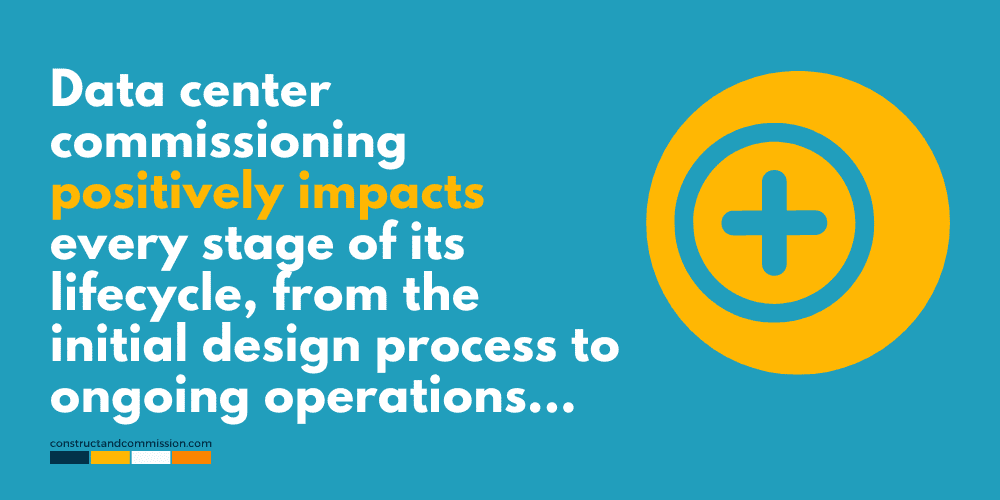
🟩 Benefits of Data Center Commissioning
The advantages of data center commissioning positively impact every stage of its lifecycle, from the initial design process to ongoing operations.
A well-deployed process provides data centers with numerous benefits, as noted below:
- Initial Design Process
- Tendering and Contractor Selection
- Construction Design Process
- Quality of Installations
- Documented Systems and Efficient Operations
- Critical System Operation and Performance
- Comfort and Satisfaction of the End User
- Handover and Operational Transition
- Facilities Teams Training
- Ongoing Support
- Lessons Learned and Continuous Improvement
🟧 Initial Design Process
The deployment of Commissioning within a Data Center Build Programme should start in the earliest stages of its development. Usually at the Pre-Design / Level 0 Design.
By integrating the process and expertise during this early stage, the facility can be tailored to optimal performance from the outset.
It also helps minimize future complications and ensures that systems align seamlessly with their operational expectations.
🟧 Tendering and Contractor Selection
Commissioning influences the tendering process, aiding the client and project team in guiding the selection of contractors with the correct expertise to execute the project, including one of the most critical stages of commissioning.
When the commissioning team is used correctly, not just as a tick box delivery, the client has at their disposal experience that is equipped to review and advise on the selection meticulously.
🟧 Aid in the Construction Design Process
Commissioning can help bridge the gap between design theory and its tangible functionality.
Using the Commissioning Team to help review the construction stage designs, specifications, and drawings aids the overall project in meeting its overall design intent by catching issues early that should be easily fixable.
🟧 Quality of Installations
Commissioning a data center is not just about understanding if the systems are operating correctly; there is also a significant element of helping and contributing to ensuring that the quality of the installations meets the design and client expectations.
The commissioning team should regularly complete inspections to ensure that the systems and services are installed in line with the drawings and overall project expectations.
🟧 Documented Systems and Efficient Operations
A well-developed Commissioning Process requires comprehensive documentation to be created and maintained, ensuring that all aspects of the data center operation and commissioning are well-documented.
Having a repository of information can significantly assist in efficient operations, allowing teams to navigate the facility precisely and clearly.
🟧 Efficiently Validated System Performance
The commissioning team ensures the optimal performance of operational systems by testing them against design benchmarks.
This rigorous assessment improves the efficiency of power distribution, cooling mechanisms, and overall functionality of the data center.
🟧 Ensuring the Comfort and Satisfaction of the End User
Commissioning helps to ensure that end-user comfort remains paramount, with temperature controls, airflow management, and security measures seamlessly integrated to create a user-centric environment.
🟧 Seamless Handover and Operational Transition
The commissioning process helps facilitate a smooth transition from construction to operations by ensuring design intent is aligned with practical implementation. This results in systems functioning as expected right from the start.
🟧 Helping Facilities Teams through Training
Knowledge transfer is essential for helping the facilities teams to manage and maintain the data center facility effectively.
The team can optimize ongoing operations using their expertise by providing training and sharing knowledge.
🟧 Ongoing Support and Operational Excellence
Commissioning’s influence extends beyond implementation. It provides ongoing support during the occupancy and operations stages, helping facilities maintain peak performance, troubleshoot issues, and adapt to evolving demands.
🟧 Valuable Lessons Learned and Continuous Improvement
Throughout the Commissioning Process, it will capture invaluable lessons learned that are documented and used correctly and can serve as a foundation for continuous enhancement within the facility or on future projects.
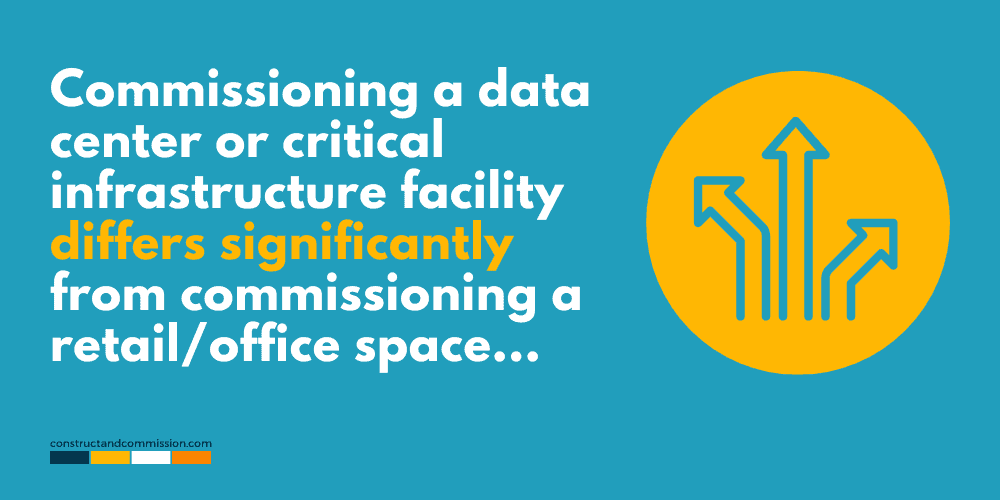
🟩 Data Center Vs. Office Commissioning
Commissioning a data center or critical infrastructure facility differs significantly from commissioning a retail/office space due to the data center’s unique demands, essential nature, and criticality to ensure continuous and reliable operation.
Below are some key differences:
| Data Center | Commercial Office | |
|---|---|---|
| Criticality & Reliability | Demand unparalleled reliability and uptime. Rigorous testing ensures uninterrupted operations and minimal downtime. | Reliability is essential but not as critical. Offices may tolerate occasional downtime for maintenance. |
| Testing Intensity | Stringent testing involves diverse scenarios, failure modes, and disaster recovery simulations with a more extensive sampling/witness rate. | Testing is generally less intense and focused on comfort, lighting, HVAC, etc and uses less witnessing. |
| Redundancy & Resilience | Higher emphasis on redundant systems and failover capabilities for continuous operation. | Redundancy exists but might not be as extensive or prioritized. |
| Security & Access Control | Requires stringent security measures due to sensitive data and critical infrastructure. | Security measures are present but may not be as robust. |
| HVAC & Cooling | Cooling systems are highly specialized for precise temperature and humidity control. | HVAC systems focus more on occupant comfort. |
| Power Distribution | Power distribution is meticulously designed to handle high loads and support uninterruptible power supply (UPS) systems. | Power distribution supports standard office equipment. |
| Load & Capacity Planning | Requires meticulous planning to accommodate future growth and changing technology needs. | Load planning is based on expected occupancy and typical office equipment. |
| Monitoring & Management | Advanced monitoring systems track temperature, humidity, power usage, and performance. | Monitoring is less extensive, focusing on essential comfort and energy efficiency. |
| Disaster Recovery & Business Continuity | Rigorous testing of disaster recovery plans and failover systems is paramount. | Disaster recovery planning is less intensive. |
| Environmental Controls | Precision control of environmental factors is essential for equipment performance. | Focuses on occupant comfort with less stringent environmental control. |
| Documentation & Reporting | Comprehensive documentation of systems, configurations, and testing is critical. | Documentation is important but may not be as exhaustive. |
| Training & Expertise | Personnel require specialized training to manage complex systems and emergency scenarios. | Training focuses on basic system operation and maintenance. |
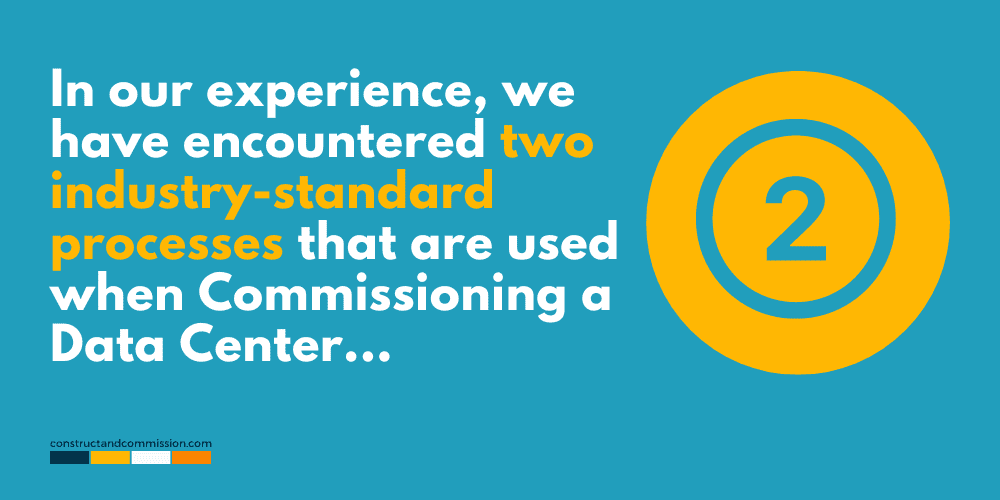
🟩 Data Center Commissioning Process
In our experience, we have encountered two industry-standard processes that are used when Commissioning a Data Center.
The first process, and the most common, is the ‘Data Center Levels framework’, which uses Levels 0 to 6, to serve as a structured roadmap, the process can not progress to the next level unless the previous one has been completed.
The second process is the ASHRAE Commissioning Process. The ASHRAE Commissioning Process, outlined in Guideline 0, is a comprehensive and systematic approach to ensuring the effective performance and reliability of a data center’s mechanical and electrical systems. This process is designed to validate that the data center’s infrastructure and equipment are installed, operated, and maintained according to specified design criteria and industry standards. The ASHRAE Commissioning Process aims to optimize energy efficiency, minimize risks, and enhance the overall operational resilience of the data center, covering a range of areas, including equipment performance testing, system integration, documentation, and ongoing monitoring, with a strong emphasis on sustainability and environmental responsibility.
🟧 Which is Best to Deploy?
The Level Process is best to deploy in a data center environment, they work well and keep the team focused on the outcomes.
There are cross-overs with the ASHRAE process as there is a lot of commonality with the documentation and training of facilities teams.
🟧 Highlevel Overview of Levels 0, 1, 2, 3, 4, 5 & 6
Below is a summary of the Levels that we have seen and had experience with, as noted above each should be completed prior to the next starting.
🔗 To read more about the Levels and how to deploy them, see our overview article | DATA CENTER | 0, 1, 2, 3, 4, 5, 6 Levels of Commissioning
- Level 0 – Design and Planning: Level 0 of the data center commissioning process sets the foundation for successfully deploying the data center commissioning process. A skilled and accountable team is assembled, a robust design is ensured via design reviews, and transparent procedures and documentation standards are established. This stage acts as the basis and sets out the direction for subsequent commissioning activities to achieve optimal performance, efficiency, and facility reliability; 🔗 click here for specific information on delivering Level 0.
- Level 1 – Factory Witness Testing: Level 1, managed by the General Contractor, focuses on conducting factory testing, manufacturer quality control checks, generating reports, and coordinating equipment shipping. It serves as a quality control checkpoint; 🔗 click here for specific information on delivering Level 1.
- Level 2 – Component Delivery, Installation & Pre-Startup/Pre-Functional Testing: Managed by the General Contractor, the focus of Level 2 is to ensure that all systems, equipment, components, and equipment is delivered, installed, and checked according to project requirements and to ensure quality. Completing the pre-functional checks is a crucial aspect of Level 2 as it sets the foundation for systems’ functional and dynamic testing in the following phases; 🔗 click here for specific information on delivering Level 2.
- Level 3 – Systems Start-up: Led by the General Contractor, Level 3 focuses on energizing and activating equipment and systems in alignment with design intent. This ensures functionality, accurate settings, and comprehensive site testing, final documentation is completed and managed, issues are addressed, and systems are primed for Level 4 testing; 🔗 click here for specific information on delivering Level 3.
- Level 4 – Component / System Functional Performance Testing: Level 4, led by the Owners Commissioning Consultant with General Contractor support, integrates and rigorously tests systems for performance alignment. It validates equipment operating modes, interlocks, and sequence of operations. Detailed documentation, issue resolution, and readiness for Level 5 integrated testing. Comprehensive training is also conducted to equip the facilities team for effective data center management; 🔗 click here for specific information on delivering Level 4.
- Level 5 – Integrated Systems Testing: Guided by the Owners Commissioning Agent with General/Main Contractor support, Level 5 marks the conclusive phase of system performance validation. Under approved failure scenarios, rigorous integration and testing encompass functionality, interoperation, and failure response. Key elements include script development, stakeholder engagement, permit acquisition, documentation, and final reporting, with comprehensive training and closeout; 🔗 click here for specific information on delivering Level 5.
- Level 6 – Closeout / Turnover / Handover: Level 6, managed by Owners Commissioning Consultant with General Contractor support, concludes the Data Center Commissioning Process. It focuses on smooth facility transition to the Owner and Facilities Team. Key aspects encompass documentation compilation, site inspection, issue resolution, equipment verification, and insights capture. This phase ensures an optimized and informed handover, marking the final step toward operational readiness; 🔗 click here for specific information on delivering Level 6.
🟧 Highlevel ASHRAE Process
As noted in ‘The Commissioning Process Guideline 0’, the ASHRAE Commissioning Process is broken into 5 Stages: Pre-Design, Design, Construction [Pre-Construction, Construction, Commissioning], Occupancy and Operations, and Continuous Commissioning.
🔗 To read more about the ASHRAE Commissioning Process and how to deploy it, see our detailed article | THE COMMISSIONING PROCESS | Explained [with download flow]
It outlines the steps, tasks, responsibilities, and activities required to ensure that a data center’s systems, equipment, and services are commissioned, completed, and documented in a structured, methodical way.
- Pre-Design Stage: The Pre-Design Stage involves forming a commissioning team, defining the owner’s requirements, establishing design principles, budgeting, planning, creating report formats, setting acceptance criteria, managing documentation, and identifying training needs for a systematic commissioning process.
- Design Stage: Stage 2, encompasses two key aspects: evaluating building systems and advancing commissioning from pre-design to pre-construction. Activities include monitoring/updating project requirements, managing design principles, conducting reviews, holding meetings/workshops, creating checklists, selecting monitoring software, finalizing templates, developing commissioning and training programs, structuring O&M processes, and refining commissioning scope, plan, and budgets. Additionally, involvement in contractor tenders occurs.
- Construction Stage: In Stage 3, the Construction Phase of the Commissioning Process involves simultaneous commissioning activities and building service installations. The focus is on completing necessary commissioning documents, overseeing onsite work, testing function, and finalizing document handover. It is divided into three sub-stages to simplify the process: Pre-Construction, Construction, and Commissioning. Activities include reviews, updating project requirements and design principles, kick-off meetings, updating plans and reports, material approvals, testing management, program approvals, training, testing method statements, documentation development, witnessing, integration testing, and ultimately, creating manuals and completing the handover.
- Occupancy & Operations: Stage 4, begins after project handover, coinciding with the defects liability period (typically 1-2 years) while under the management of the building operator. The stage emphasizes commissioning closure, defect resolution, and documentation finalization. Activities involve defect clearance, seasonal testing, advanced training for facility staff, updating project requirements and design principles, finalizing the commissioning report, assessing facility performance, conducting lessons learned sessions, and completing systems, operations, and maintenance manuals.
- Continuous Commissioning: [if used] This stage follows project handover and coincides with Stage 4’s occupancy and operations, lasting the facility’s life cycle or to the clients requirements. If using Monitoring-Based Commissioning [MBCx], Fault Detection and Diagnostics [FDD], or Automated FDD [AFDD] systems, they’re integrated. Activities include finalizing system installations, gathering reports from these systems, coordinating remedial actions, optimizing systems based on reports, updating project requirements and design principles, revising the commissioning report, and updating manuals.
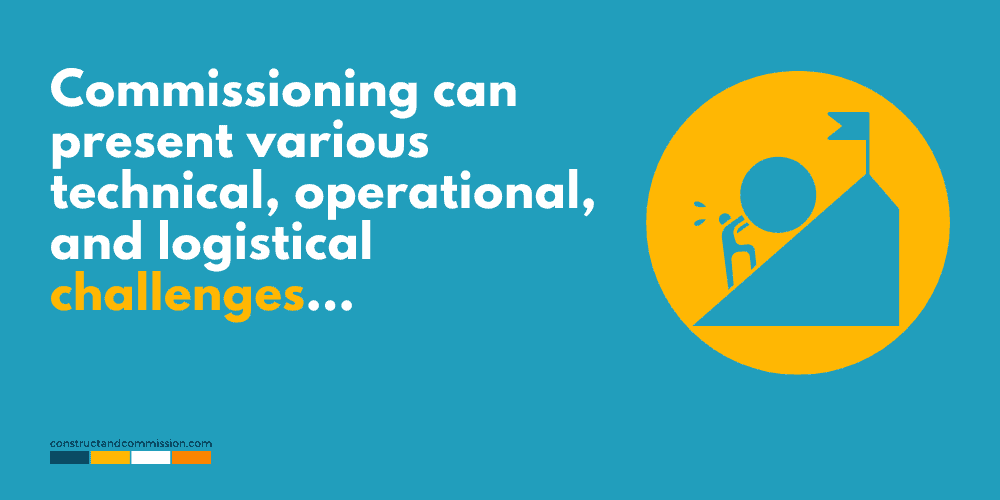
🟩 20 Challenges when Commissioning a Data Center
Commissioning can present various technical, operational, and logistical challenges. Here are 20 general challenges that can arise during the commissioning process:
❌ Clear Brief: On some projects, if the clients are not used to the early deployment of commissioning activities, a clear brief can sometimes be hard to come by, creating confusion and reworking.
❌ Clear Commissioning Scope: A detailed commissioning scope is essential. Without it, General Contractors may not deliver commissioning aligned with expectations.
❌ Late Employment of the CxA: The Commissioning Agent should be onboard at the Pre-Design Stage to provide advice and instructions on the commissioning. Late involvement can usually have significant impacts.
❌ Stakeholder Collaboration: Effective communication and collaboration among design, construction, and operational teams is crucial.
❌ Lack of Standardization: Differing protocols, standards, and processes between the data center developers and end users can sometimes create confusion and hinder efficient commissioning.
❌ Budget Constraints: Balancing commissioning costs with project budget constraints can pose financial challenges.
❌ Scope Creep: Expanding the commissioning scope beyond the initial plan can complicate the process or if people change their minds on requirements late.
❌ Changing User Needs: User requirements may evolve during the project programme, necessitating system adjustments and updates.
❌ Timeline Pressures: Meeting commissioning deadlines while maintaining quality can be demanding, especially if the construction programme overruns.
❌ Not Ordering Equipment on Time: Delays in ordering equipment can disrupt the overall program timeline, impacting commissioning activities.
❌ Availability of Temporary Tools, Equipment, and Instruments: Adequate availability and readiness of temporary tools, equipment, and instruments for testing can significantly impact the efficiency and accuracy of the commissioning process.
❌ Resource Allocation: Efficiently allocating personnel, equipment, and resources for testing and validation can be challenging.
❌ Vendor Coordination: Coordinating with multiple vendors and suppliers to align systems can be complex.
❌ Complex System Integration: Coordinating multiple building systems and ensuring seamless integration can be complex and time-consuming.
❌ Interoperability Issues: Ensuring different systems communicate effectively and share data without complications can be challenging.
❌ Design vs. Reality Discrepancies: Discrepancies between design intent and actual implementation/operation can impact system performance.
❌ Documentation Management: We still love paper; properly organizing and maintaining extensive documentation can be overwhelming, especially on large projects.
❌ Performance Validation: Ensuring systems perform as intended under various scenarios requires rigorous testing; an unrealistic programme can hinder this.
❌ Facilities Training: Ensuring facility personnel are adequately trained to operate and maintain the systems post-commissioning is crucial.
❌ Post-Commissioning Works: Addressing unresolved issues or performance discrepancies after completion of commissioning in a live environment.

🟩 Systems to be Commissioned
Various critical systems will be inspected and commissioned in a data center project to ensure proper integration, functionality, and performance.
Here is a list of systems that are typically commissioned:
| System | Type |
|---|---|
| Electrical Systems | Power Distribution and Redundancy |
| Uninterruptible Power Supply (UPS) Systems | |
| Emergency Backup Generators | |
| Fuel Systems | |
| Transfer Switches | |
| Power Monitoring and Metering | |
| Power Management Systems | Power distribution units (PDUs) |
| Remote power monitoring and control | |
| Load balancing and management | |
| Mechanical Systems | HVAC (Heating, Ventilation, and Air Conditioning) |
| Precision Cooling Systems | |
| Chilled Water Systems | |
| Fire Suppression Systems | |
| Environmental Monitoring and Control | |
| Water & Drainage Systems | Drainage and Waste Water Systems |
| Potable Water Systems | |
| Booster Water Systems | |
| Filtration Systems | |
| Leak Detection Systems | |
| Water Quality Monitoring | |
| Chemical Treatment Systems | |
| Redundancy & Fall Over Systems | Redundant Equipment and Systems |
| Failover Mechanisms for Power and Network | |
| Emergency Systems Emergency Systems | Emergency Lighting |
| Evacuation Systems | |
| Emergency Communication Systems | |
| Cooling & Ventilating Systems | Hot/Cold Aisle Containment |
| Airflow Management | |
| Fire Detection and Suppression Systems | Smoke and Heat Detectors |
| Aspirating Detection Systems | |
| Fire Alarm Systems | |
| Clean Agent or Inert Gas Fire Suppression Systems | |
| Building Management & Monitoring Systems | Building Management System (BMS) or Building Automation System (BAS) |
| Environmental Monitoring and Control | |
| Energy Management and Monitoring | |
| Energy Efficiency and Sustainability Systems | Energy-Efficient Lighting |
| Renewable Energy Integration | |
| Monitoring and Reporting on Energy Consumption | |
| Physical Security Systems | |
| Surveillance Cameras | |
| Access Control Systems | |
| Intrusion Detection Systems | |
| Data Cabling and Network Infrastructure | Structured Cabling Systems |
| Network Switches and Routers | |
| Fiber Optic Cabling | |
| Network Connectivity and Communication | Network Connectivity |
| Network Redundancy and Failover | |
| Disaster Recovery and Business Continuity Systems | Disaster Recovery Plans and Failover Procedures |

⬜ Data Center Commissioning Guideline Template
To help us expand the site and create more resources, we made the document below in [Microsoft Word] & [Microsoft Excel] for download.
Click the ‘Buy Here‘ button to purchase the fully editable copy, which can be used immediately.
🔗 To read more on what a Commissioning Guideline is and how to write one, see our article | DATA CENTER | Commissioning Guideline Template
You will be directed to our shop page.
🚀 Includes a copy of the Data Center Commissioning Checklist shown at the end of this article.
⬛ Related Articles
LEVEL 6 – DATA CENTER Cx | Turnover & Handover
CRAC UNIT | Functional Testing Example + Template
DATA CENTER | Commissioning Checklist
DATA CENTER | 0, 1, 2, 3, 4, 5, 6 Levels of Commissioning
CRAC UNITS | What are they?
DATA CENTER | Commissioning Guideline & Template


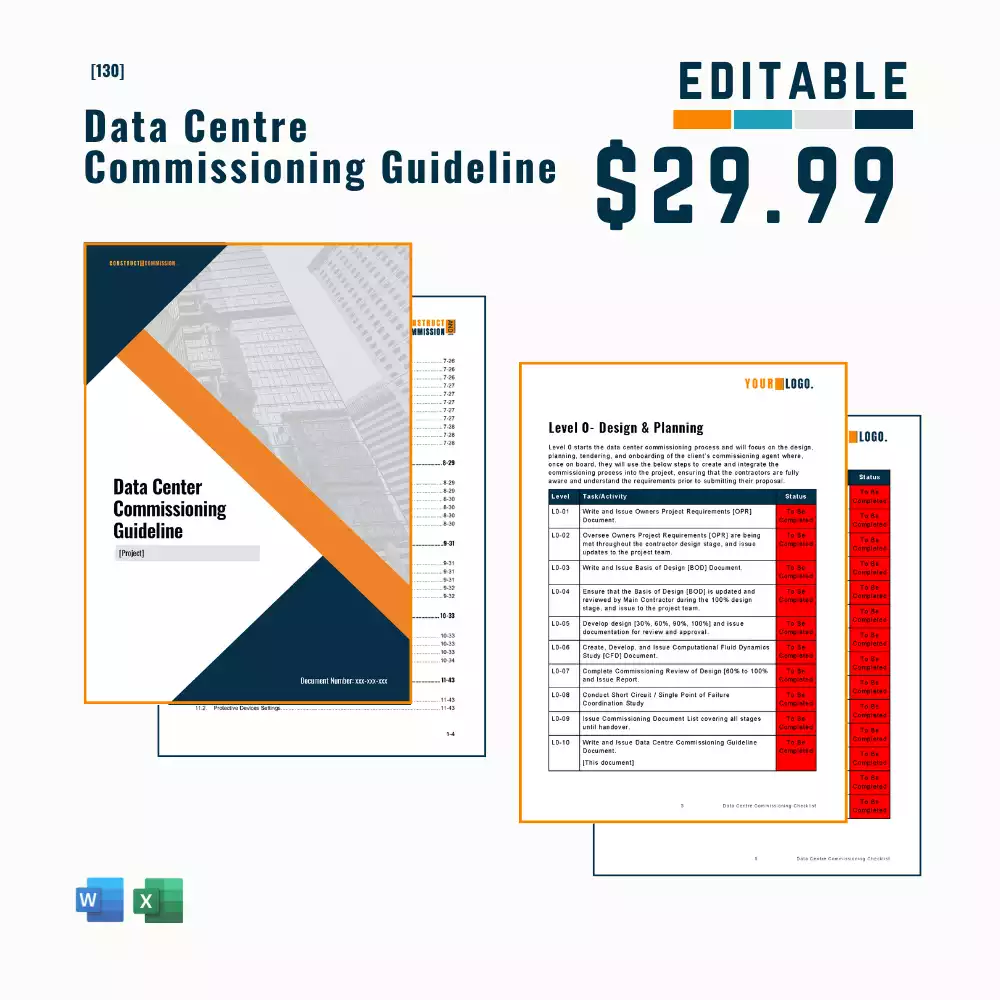
![Data Center Commissioning Checklist [MS Word] & [MS Excel]](https://constructandcommission.com/wp-content/uploads/2023/07/066-Data-Center-Commissioning-Checklist-Shop.webp)
